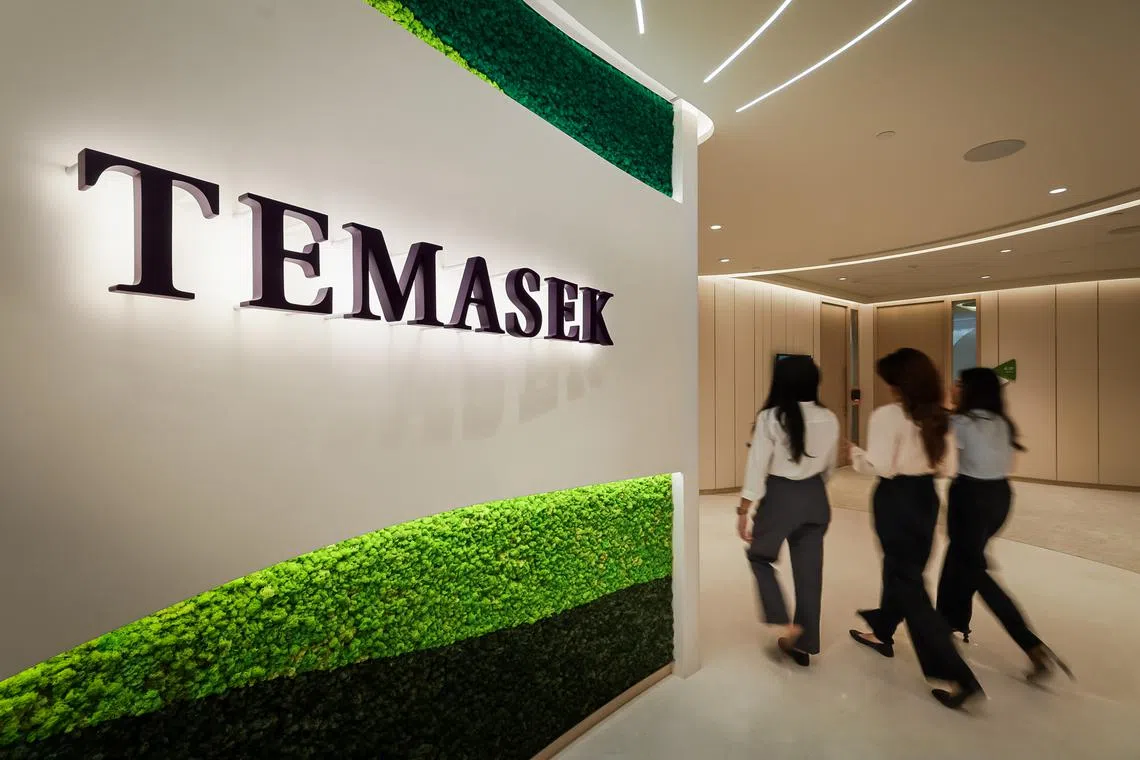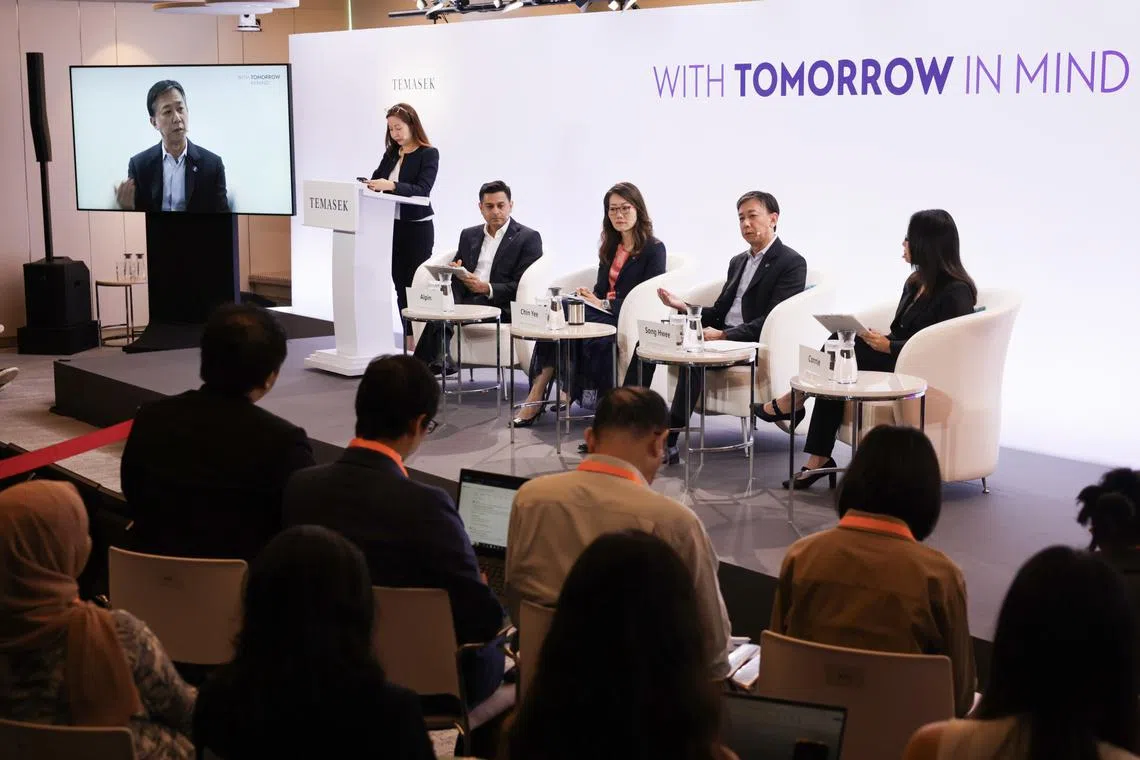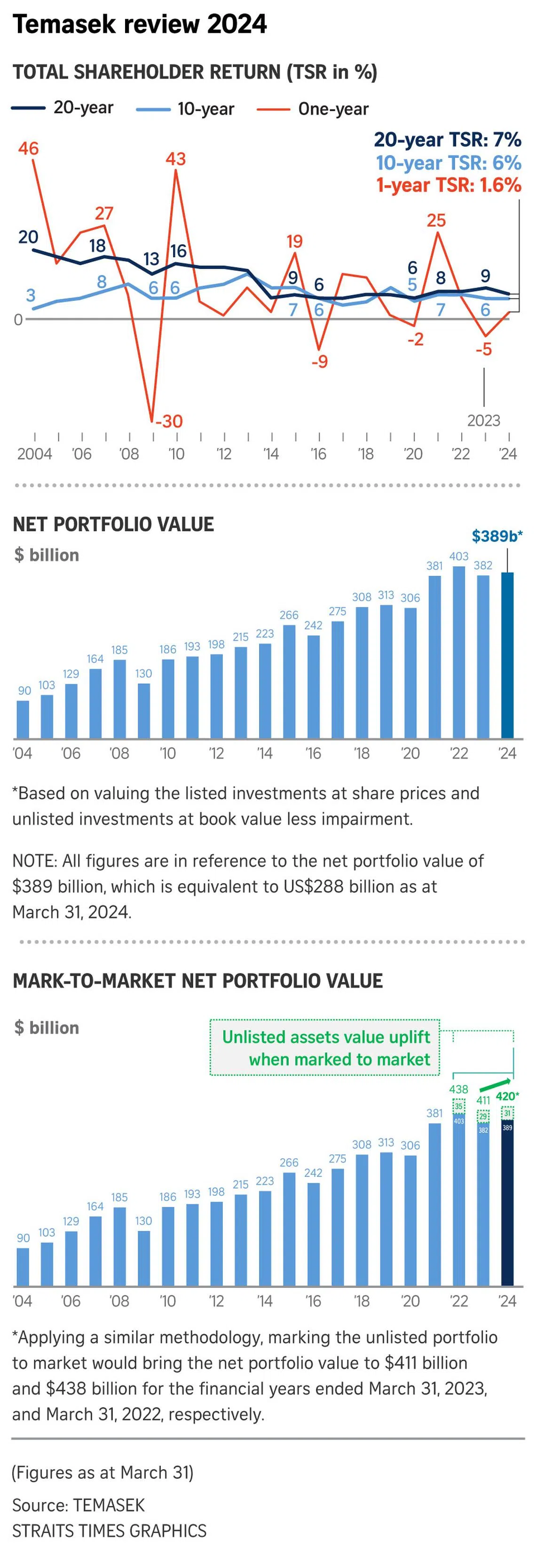Temasek reports $7 billion rise in net portfolio value to $389 billion
Sign up now: Get ST's newsletters delivered to your inbox

The increase in net portfolio value was mainly due to higher returns from the US and India.
ST PHOTO: GAVIN FOO
Follow topic:
SINGAPORE - Singapore’s investment company Temasek’s net portfolio value came in at $389 billion for the financial year ended March 31, 2024, up $7 billion from a year ago
The increase was mainly due to higher returns from the United States and India, but the portfolio was also weighed down by the underperformance in China’s capital markets, the company said on July 9.
Net portfolio value represents the total market value of all the assets in an investment portfolio minus any liabilities. It provides a clear picture of the actual worth of the portfolio at a given point in time.
After marking its unlisted assets to market, the net portfolio value is $420 billion, an increase of $9 billion from a year ago.
Mark-to-market value is an accounting practice that involves recording the value of an asset according to its current market price, rather than its book value or original cost.
Temasek’s unlisted investments comprise the majority of its investment portfolio.
The investment company has been disclosing the mark-to-market value of its unlisted assets since 2022. It further refined the methodology this year to be in line with market practices. For example, if an investee company had a recent funding round, the funds raised will be used as a guide to value the company.
In a measure of Temasek’s long-term portfolio performance, the 20-year total shareholder return (TSR) came in at 7 per cent, while the 10-year TSR stayed at 6 per cent for the second straight year.
The 20-year TSR fell from 9 per cent a year ago to 7 per cent in the financial year ended March 2024 because it excludes the post-Sars recovery in 2004 when returns jumped 20 per cent.
The one-year TSR, which is more volatile, reversed from a negative 5.07 per cent in the last financial year to a positive 1.6 per cent.
The one-year figure has dipped into negative returns four times since 2004, recording the biggest drop of 30 per cent in 2009, following the global financial crisis.
Temasek’s deputy chief executive Chia Song Hwee said the 10- and 20-year TSRs are more indicative of the firm’s performance because they provide a long-term view of its investments.
“We have to accept the annual fluctuation in the numbers,” he said.
“We are not a day trader or investor.”
What is important is whether Temasek’s underlying assets can continue to perform well in the future, Mr Chia added.

(From left) Moderator Lena Goh and Temasek International panellists: head of real estate and deputy head of private equity fund investments Alpin Mehta, chief financial officer Png Chin Yee, deputy CEO Chia Song Hwee and head of financial services Connie Chan.
ST PHOTO: GIN TAY
Singapore remains the biggest market for the company, accounting for 27 per cent of its underlying assets in financial year 2024.
A total of 53 per cent of Temasek’s portfolio companies are also headquartered in Singapore.
However, the Americas have replaced China as the second-biggest market for the investment firm.
Now, the Americas comprise 22 per cent of Temasek’s underlying assets, from 21 per cent in 2023.
Underlying exposure to China has dropped to 19 per cent, from 22 per cent a year earlier.

Temasek’s head of financial services Connie Chan said the firm has been actively reshaping its investment portfolio to where it sees the best risk-reward.
Since 2016, its investment approach has also been guided by four structural trends – digitisation, sustainable living, future of consumption and longer lifespans – which sees it investing in companies that directly enable, drive and benefit from these trends.
Take financial services that Ms Chan heads, for example. Ten years ago, the portfolio consisted primarily of banks. Today, it is 50 per cent in banks, but the other half is invested in sectors like digital payments, financial software or insurance, she said.
“These are really sectors that benefit from long-term secular trends, like digitisation, or like longer lifespans in the case of insurance,” she added.
Mr Chia said this approach of diversification has allowed Temasek to build up a resilient portfolio across different market cycles.
“During the bull market, we may not be at the top in performance, but hopefully, at a lower market, our portfolio will be able to withstand better,” he added.

In FY2024, the company invested $26 billion in areas aligned with the four trends, such as technology, financial services, sustainability and healthcare.
It divested $33 billion for the year, of which $10 billion was due to the repayment of bonds by Singapore Airlines and redemption of preference shares by Pavilion Energy.
That resulted in a net divestment of $7 billion, compared with a net investment of $4 billion in FY2023.
Temasek’s portfolio exposure to the four structural trends of digitisation, sustainable living, future of consumption, and longer lifespans has steadily increased from 13 per cent in 2016 to 31 per cent in 2023 and 39 per cent in 2024.
Today, financial services, and transportation and industrials remain the two largest sectors that it is invested in.
The investments are in a mix of listed and unlisted assets, with unlisted assets accounting for 52 per cent of the portfolio and listed assets the remaining 48 per cent.
Temasek’s chief financial officer Png Chin Yee said the unlisted assets have generated returns of 9 per cent a year over the past decade, outperforming the overall portfolio return of 6 per cent.
About a third of Temasek’s unlisted portfolio – 31 per cent – is in Singapore companies such as PSA, SP Group and Mapletree.
Temasek also has direct investments (35 per cent) in private companies, including those in the early stage.
Some examples of these investments are health and beauty retailer AS Watson Group; Element Materials, which tests and certifies products and materials used in industries ranging from oil and gas to aerospace; and Indian healthcare provider Manipal Hospitals.
Responding to concerns that unlisted assets are not as liquid – cannot be easily converted into cash in a short period of time – as listed assets, Temasek said some of the unlisted assets will go public eventually.
Mr Chia said many of the listed companies in Temasek’s portfolio today were unlisted previously.
He cited European payments company Adyen as an example. Temasek started investing in the company when it was a small start-up in 2014. Adyen subsequently went public in 2018 on the Amsterdam Stock Exchange.
“You will see that kind of evolution, you can think about it this way, that our listed portfolio comes from the pipeline of unlisted portfolio,” added Mr Chia.
Ms Chan noted that Temasek does not use public listing to make a profit or divest its investments. It will hold on to the investment if it continues to see value in the listed company.
Some of the other Temasek portfolio companies that have listed in the past five years include food delivery company DoorDash, which is listed on Nasdaq; food delivery platform Zomato, which is listed on the National Stock Exchange of India; and Intapp, a provider of artificial intelligence (AI)-powered solutions for professional services firms, which is listed on the Nasdaq.
Looking ahead, Temasek said the global economy has been more robust than expected, and recession risks in key developed markets such as the US have mostly subsided.
Mr Alpin Mehta, head of real estate and deputy head of private equity fund investments at Temasek, said inflation remains sticky in many markets, but it is coming down from elevated levels at the very least.
This would give central banks more confidence to ease monetary policy, with some already beginning the process of easing, he added.
However, geopolitical tensions remain a key concern, he said, citing US-China relations and conflicts in Ukraine and Gaza.
Mr Mehta noted that the US presidential election in November could pose more challenges for investments.
Against this backdrop, Temasek said it will remain disciplined in its investment approach, guided by its four structural trends.
In particular, the state investment firm is eyeing opportunities in the green transition and in AI.
Mr Mehta said the US will remain one of the largest destinations for its investments. Temasek also sees opportunities in Europe and has plans to increase its focus on India, South-east Asia and Japan, he added.
It is staying cautious on China, but that does not mean it is paring back or cutting its exposure in the country, Temasek said.
Correction note: This article has been edited for clarity.


